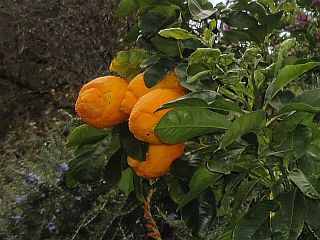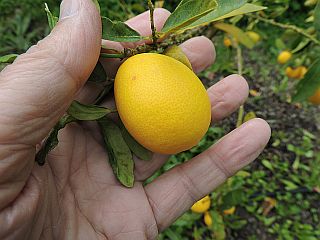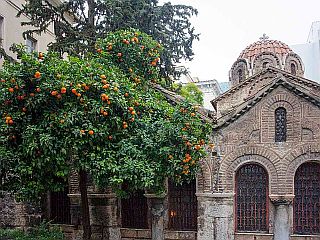» Home
» About
» Membership
» Journal
» Sparoza Garden
» Branches
» MGS Forum
» Seed Exchange
» Donations
» MGS Excursions
» Information
» Members' Gardens
» Book Reviews
» News & Views
» Contact
» Search
|
Edibles to grow in a mediterranean-climate garden:
Citrus
For much more information about growing citrus see Citrus Cultivation
Bergamot Citrus bergamia
by John Joynes, Cyprus and Fleur Pavlidis, Greece
The origins of bergamot orange (Citrus bergamia) are uncertain but a hybrid cross between Citrus medica and Citrus × aurantium is considered to be a possibility.
Bergamot is the source of the oil well known as the flavour of Earl Grey and Lady Grey teas among others as well as confectionery such as Turkish Delight. Also it is used to scent cosmetics and perfumes, being one of the components of the original Eau de Cologne.

Bergamot or Citrus bergamia in January

Bergamot fruit
The aesthetic attraction of this citrus tree lies in the characteristic bunches of dark yellow fruit which hang on the tree throughout the winter. Although, as can been seen from the photograph, the untreated tree will suffer from leaf curl, it is not unduly knocked back by the disease. This specimen is demonstrating its toughness by growing in a narrow planter about 40 cm deep built on the natural soft white chalk rock and with competition from Crocosmia. It gets drip irrigation twice a week in the summer. It is probably as hardy as the bitter orange, resisting lower temperatures than lemon and sweet orange trees. Unfortunately the blossom is not as heavily scented as its more tender cousins,
The zest from the ripe fruit can be used to replace lemon in cakes, ice-cream and sorbet. A traditional Greek ‘spoon sweet’ is made from rolls of the peel boiled in syrup which brings out the highly aromatic taste.
Recipe: Bergamot and Orange Sorbet
While the zest of the bergamot is wonderfully aromatic and imparts its scent as a taste, the juice is rather characterless. You can use part orange juice part bergamot juice in this recipe but it will be much sharper in taste.
Zest of 4 bergamots
150 ml water
50 – 75 gm sugar
400 ml orange juice
- Put the water, sugar and zest into a pan and heat gently until the sugar has melted.
- Boil for one minute then leave to cool.
- Strain the syrup into the juice, taste for sweetness and correct with more juice or syrup.
- Leave covered in the fridge.
- Once fridge-cold use in the usual way in your ice-cream maker or pour into a plastic box and freeze, smashing occasionally if you don’t like icy bits.
December 2015
Limequat Citrus aurantiifolia x Fortunella japonica
by Caroline Forsyth, New Zealand
The limequat is a cross between the key lime (Citrus aurantiifolia) and either the round kumquat (Fortunella japonica),producing what is known as the Eustis limequat, or the oval kumquat (Fortunella marginata)producing the Tavares limequat. It is generally believed that the hybridization was undertaken by Walter Tennyson Swingle in Florida in the early 20th century, although some sources state that the limequat originated in China.
The limequat is covered in either fruit or blossom almost all year round, and makes an ornamental and relatively low-growing hedge. The flowers are not heavily scented, but there are no thorns, and the leaves in a well-fed specimen are shiny and attractive. The fruit, which are about the same size as a lime, start out dark green and turn acid yellow when they are ripe. They can be used in any recipe where limes are specified, although they have many more pips than a lime.

Limequat hedge

Limequat fruit
Limequats are tough, coping with wind, low temperatures and limited watering once they get established. The specimen in the photo is part of a hedge planted in a bed carved out of pure clay, with a good layer of topsoil and mulch on top. The usual range of citrus pests – aphids and scale in particular- attack it, but can be dealt with by the occasional squirt of “bug oil”. The hedge is fed at least twice a year with a mixture of citrus fertiliser and sheep pellets. Irrigation is sporadic, maybe once a fortnight in the summer through a seep hose connected to the water tank. The hedge gets a good haircut in late winter before flowering starts. Now that it is well-established, it produces enough fruit to make copious quantities of fabulous tart marmalade and hot pickle.
Recipe: Hot Limequat Pickle
10/12 limequats
2 tablespoons salt
1 teaspoon crushed chilli (adjust quantity to taste)
1 tablespoon garam masala
2 tablespoons sugar
6 cloves garlic, crushed
½ cup oil (I use canola)
3 large onions, finely chopped
2 cups malt vinegar
- Roughly chop the limequats, discarding the seeds and place in a large bowl.
- Mix the salt, chilli, garam masala, sugar and garlic together. Sprinkle the mixture over the limequats and toss well to coat thoroughly. Cover the bowl and leave to marinate overnight.
- Next day heat the oil in a heavy-bottomed saucepan, add the finely chopped onions and cook until soft but not browned. Stir in the chopped limequats and their juices and scrape in all the spices from bowl.
- Cook the mixture in the oil, stirring continuously, for 15 minutes. Pour in the vinegar and bring the pickle to the boil.
- Cover the saucepan and simmer for one hour. Stir frequently to prevent sticking.
- Spoon the pickle into hot, clean jars and seal.
- Ready for use in 2 weeks. Delicious with curries, cold meats or cheeses.
December 2015
Bitter Orange Citrus × aurantium
For cultivation of Seville and other bitter oranges see Citrus Cultivation
Bitter orange trees are usually treated as ornamental. They are the hardiest of the citrus trees and provide rootstock for the more tender lemon and sweet orange trees. Pruned into neat lollipop or umbrella shapes, they line urban and suburban streets and scent the air with their blossom. Every garden should have at least one for the olfactory pleasure they give. The fruits can also be used as in the recipes below.

Bitter orange as street trees in Athens from MGS Facebook January 2016
Recipe: Seville orange marmalade
by Mary Wilbur from her article Oh! My Marmalade in The Mediterranean Garden No 48 October 2007.
8 medium bitter oranges
2 lemons
8 cups water
sugar to taste (6 to 8 cups)
- Cut oranges and lemons in half, remove seeds and squeeze juice into a large bowl. Put seeds in a small bowl and cover completely with cold water. Slice oranges and lemons (thin or thicker, according to taste) and add to juice in large bowl. Cover with the 8 cups of water. Let both bowls stand, covered, for 24 hours.
- Transfer contents of large bowl to preserving pan. Pour contents of small bowl through a sieve, mashing the seeds to extract the pectin. Discard the seeds and add the gelatinous remains to the pan. (Alternatively, pour the seeds and liquid into a bag of cheesecloth and add to the preserving pan.)
- Simmer mixture gently for about one hour, until the peel is soft and the contents of the pan are reduced.
- Add the sugar to the pulp and bring to a boil, stirring until sugar dissolves. Boil rapidly for about 45 minutes or until two drops form on the edge of a spoon and drop off simultaneously. For a stiffer marmalade, continue cooking until the drops run together as they fall off the spoon.
- Pour into sterilized jars and seal.
Recipe: Split pea soup with bitter orange juice
by Charithea Joynes
We use bitter orange juice in soups made with pulses. This is a recipe that my mother and aunt used for a soup eaten during the fasting periods in winter when they followed a vegan diet in accordance with their Greek Orthodox religion.
1/2 lt cold water,
I cup of split peas
1/4 cup round grain rice
1 medium onion chopped finely
100 ml olive oil,
juice of a bitter orange,
juice of half a lemon,
salt and pepper
- Put water and split peas on to boil. Remove the froth that first appears and then add rice.
- Cook on gentle heat until rice and peas are soft.
- Cook chopped onion in the olive oil and when onions are soft add to the cooked peas and rice.
- Put all the mixture in the blender and add some of the juice of bitter orange and lemon.
- Check for flavour after you have seasoned with salt and pepper and add more bitter orange or lemon according to taste.
April 2015
Lemon, Citrus limon
For information about the cultivation of lemons see Citrus Cultivation
Recipe: Limoncello
by Helene Pizzi from her article Lemons, Lemons …and… More Lemons in The Mediterranean Garden No 10 Autumn 1997
First of all, this delicious lemon after-dinner liqueur has been sipped on the island of Ischia for a long time, but only in the last decade has limoncello suddenly become a fashionable ‘must’ all over Italy. The fragrant liqueur should be kept in the freezer, like vodka, and served in tiny chilled glasses. For several years I tried to get the locals to share their fatto in casa recipe, but no one would give out their family secrets. Finally Rosalba Andriotti, who yearly makes a trip to Sorrento just to get huge unsprayed lemons for her liqueur, kindly agreed to share her ‘secret’ recipe… which is surprisingly so very simple to make.
- Peel just the yellow rind of 1 kilo of lemons (the white pith is bitter).
- Place the rinds in a glass bowl together with 1 litre of pure 95% proof alcohol.
- Cover and set in a dark cupboard for 10 days.
- Boil 750 gm sugar with 750 gm water to make a syrup and cool completely.
- Pour the syrup into the alcohol and rinds.
- Stir well, then strain through a sieve and pour into pretty bottles (the bottles are important; choose interesting ones). Serve iced.
Recipe: Elena’s Pasta all’ Limone
by Helene Pizzi from her article Lemons, Lemons…and… More Lemons in The Mediterranean Garden No 10 Autumn 1997
This very quick pasta dish is as delicious as it is easy to prepare.
- Put a large pot of water on the stove, and while you wait for the water to boil, prepare the sauce.
- In a large serving bowl place the juice of 1 lemon, ¼ teaspoon freshly grated nutmeg, ½ teaspoon freshly ground black pepper, 2 tablespoons vegetable oil, 2 tablespoons butter and 50 gm (about a teacup full) of freshly grated Parmesan cheese.
- When the water comes to the boil, salt to taste and cook 500 gm spaghetti (or short macaroni, or shell-shaped pasta), tucking the pasta under the water with a wooden fork and then giving it a good stir to separate the strands while cooking.
Just before the pasta is cooked, add
- 2 spoons of the pasta water to the sauce.
- When the spaghetti is al dente, quickly drain in a colander, pour into the serving bowl and toss well.
- Serve hot, with extra Parmesan and black pepper, with a bottle of chilled white wine.
|


